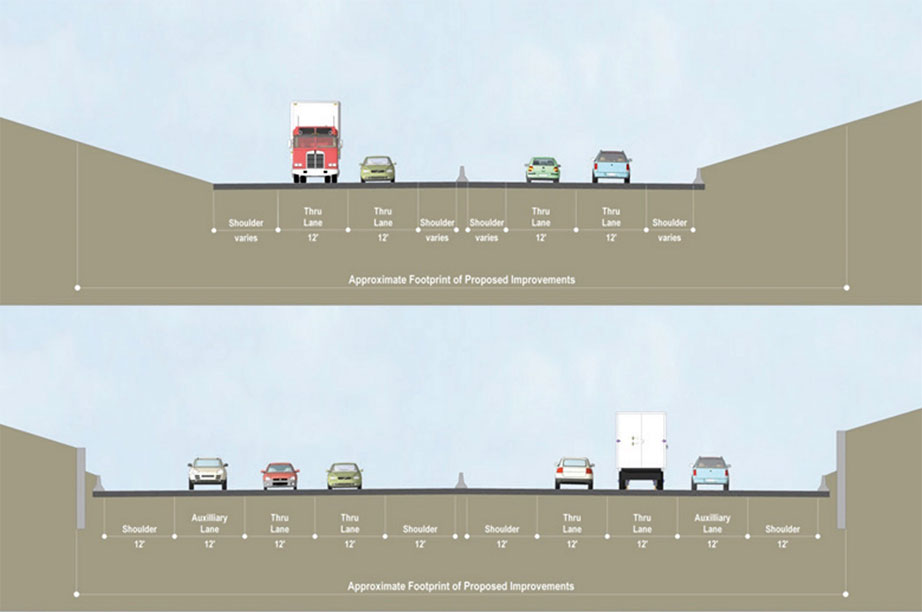
(Graphic: ODOT I-5 Rose Quarter Environmental Assessment)
As you can see in the cross-sections above, the Oregon Department of Transportation’s I-5 Rose Quarter project would significantly widen Interstate 5 through Portland’s central city. And, if the project achieves ODOT’s goals for fewer crashes and faster speeds, it would also increase the number of people who drive through the corridor.
These seem like obvious facts. I can’t believe I even need to point them out. But with just 20 days left in the EA comment period, I’m afraid many people are being misled.
“It’s imprecise to say the Rose Quarter Plan will build more freeway lanes… Saying it builds more freeway lanes leaves the impression that there will be a large scale expansion of the freeway.”
— Don Hamilton, ODOT
ODOT says they can add approximately 3.2 miles of new driving lanes and shoulders to I-5 without actually widening the freeway. They also want us to believe that an estimated $250 million in new freeway facilities will not increase the number of drivers or create an incentive for more people to use the freeway. With no induced demand, coupled with a future full of high-tech cars and stronger emission regulations, ODOT says this project would actually contribute to a reduction in emissions.
What ODOT is pitching sounds too good to be true. Because it is.
ODOT knows freeways expansions and projects that increase driving capacity are controversial and politically dicey (especially in Portland). So they’ve come up with clever ways to blur reality. The trouble is, similar to how they hid images of wider freeways and lied about greenhouse gas emissions in the marketing of their failed Columbia River Crossing project, they are misleading the public with their I-5 Rose Quarter plans.
Believe what we say, not what you see
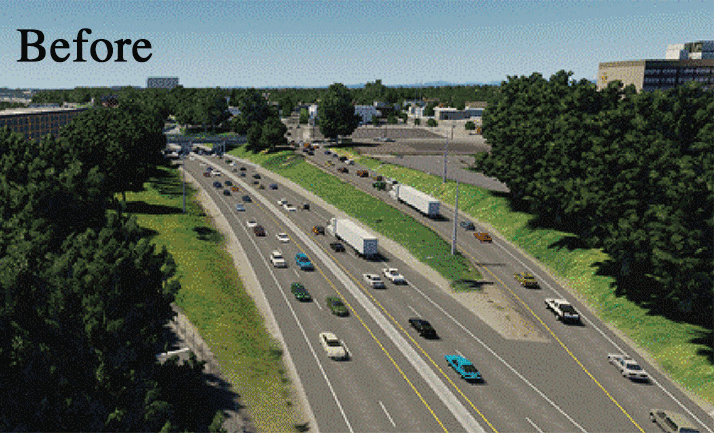
Oregon State Senator Lew Frederick represents the district this project runs through. He also sits on the powerful Joint Committee on Transportation. At a meeting with constituents Saturday morning, Portlander Kiel Johnson (who lives in Frederick’s district) asked him about the project. “He disagrees they are widening [the] freeway,” Johnson shared via Twitter. Asked to elaborate, Johnson wrote to us that Sen. Frederick said, “They are not adding two lanes but a series of on and off ramps.”
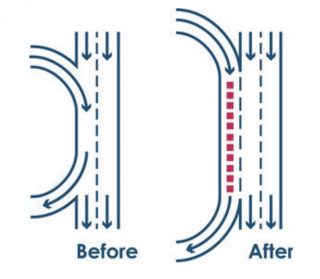
Sen. Frederick works for the people, not ODOT. Yet his answer came directly from the agency’s talking points.
According to the project’s environmental assessment (EA), ODOT wants to add 4,300 feet of freeway lanes in the northbound and southbound directions (8,600 feet or 1.6 miles total). But they don’t call them new lanes. ODOT insists on the more benign terms “auxiliary lanes” or “ramp-to-ramp” lanes (they even show a graphic in the EA (at right) that shows a version of the lanes that does not match what they propose in the project). However, as you can see in a graphic shown on page 9 of the EA (below), the new northbound lanes are ramp-to-ramp-to-ramp-to-ramp-to-ramp. And in the southbound direction they are ramp-to-ramp-to-ramp-to-ramp.

In addition to these new lanes, ODOT plans to widen the freeway by 48 more feet to make room for four, 12-foot wide shoulders on the inside and outside of the freeway in each direction for the same length as the new lanes.
Several months ago I wrote that this project was adding new freeway lanes. I got an email shortly after from ODOT Region 1 Public Information Officer Don Hamilton. “It’s imprecise to say the Rose Quarter Plan will build more freeway lanes,” he wrote. “It adds shoulders and auxiliary lanes (on-ramp to the next off-ramp)… But does not create additional through lanes and doesn’t widen the overall footprint of I-5. Saying it builds more freeway lanes leaves the impression that there will be a large scale expansion of the freeway.”
How can Hamilton say that?
Note how he said it doesn’t widen the overall “footprint”. As you can see in the lead graphic (from page 10 of the EA), ODOT has cleverly defined a very wide “footprint”. Then they propose to widen the freeway by over 24-feet, yet because it stays inside that pre-defined footprint, they can say the footprint doesn’t get larger.
Is that an honest explanation of the plans or willful obfuscation and spin?
Advertisement
When ODOT says the project, “Does not create additional through lanes and doesn’t widen the overall footprint of I-5,” how do most people interpret that? We know what Sen. Frederick thinks.
At last week’s open house, I asked Hamilton how long a lane has to be before it goes from an auxiliary lane to just a standard freeway lane. I also shared my concern that ODOT is using words like this to make the project sound better.
“To manipulate the language a little bit?” Hamilton interjected, unsolicited. “Yes,” I said, “Is ODOT doing that?” He didn’t respond directly to that question (partly because he avoided it and partly because I didn’t force him to).
“I don’t have an answer to the question of when auxiliary lane becomes a through lane,” Hamilton said.
“Why not just call it a through lane?” I asked.
“Because it doesn’t go very far,” he replied.
“If you’re connecting two freeways [more than three-quarters of a mile from each other], that’s a lane,” I countered.
Then he pivoted. “We’ve got three interstates coming together in that stretch. It hasn’t been opened up in 50 years. We’re trying to give it a little more breathing room.”
The capacity question
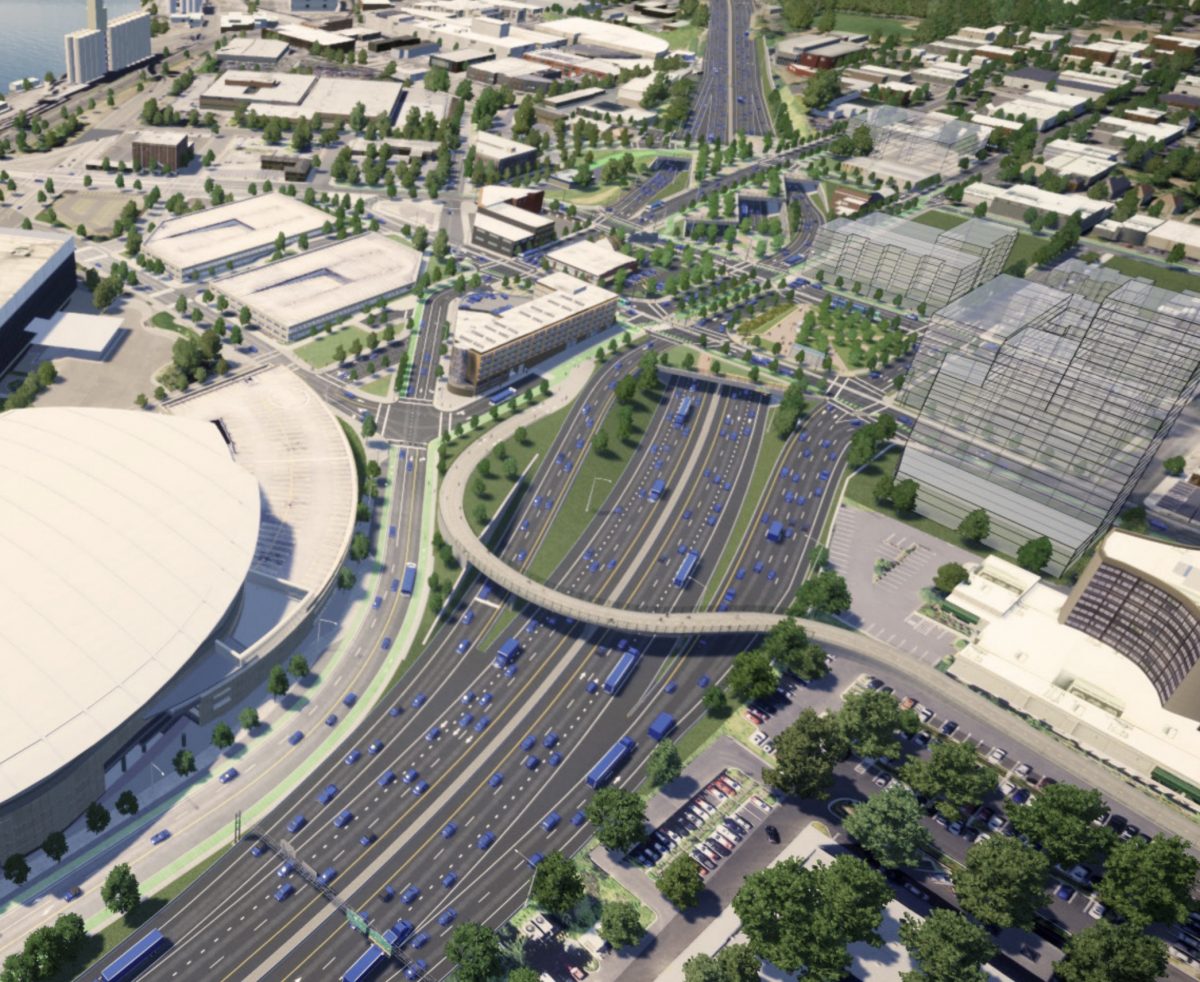
(Image: ODOT)
ODOT is playing a similar game on whether or not the project will add capacity. On page 26 of the EA, ODOT states, “The Build Alternative would not create new capacity or add substantial capacity to the existing highway.”
The Build Alternative would not create new capacity or add substantial capacity to the existing highway.
— from the EA
The project was sold to state lawmakers as “congestion relief,” yet ODOT says it won’t increase capacity. How can those two things be true?
To believe ODOT we have to agree that it’s possible to relieve congestion and increase speeds through the corridor while not adding any additional trips.
I asked Hamilton about this at the open house last week.
“If the project is successful, speeds are faster and there are fewer crashes and less congestion, it seems to me all those things would lead to more trips through the corridor,” I said.
“Why?” Hamilton replied. “Couldn’t it be conceivable that you get the same amount of traffic going through, it’s just going a little faster?”
ODOT’s position (via Hamilton) assumes there’s a finite number of drivers.
I asked again: “If there are 24 hours per day and people can get through there faster, then there are more cars per day that get through right?”
“Is that an engineering or a philosophical question?” Hamilton replied (I’m not sure why it matters).
“Philosophy aside,” I continued, “If you make something easier, people will do it more. This project will make it easier to drive through that corridor, so wouldn’t that mean there will be more trips, and more capacity?”
“It will [add capacity] because the region will grow. I don’t think an auxiliary lane in this project will cause the region to grow,” Hamilton asserted.
According to Hamilton and ODOT, an expansion of the freeway in the central city will not lead to more driving trips. They say unrelated factors like development and population growth will create more trips. To say the presence of new freeway lanes won’t have an impact on the number of trips is disingenuous at best.
The EA’s silence on induced demand surprised many people. How could such an accepted phenomenon not be on ODOT’s radar? It appears that the agency and its staff are relying on guidance from the Federal Highway Administration.
To make the case for highway widening projects throughout Oregon, ODOT completed the Corridor Bottleneck Operations Study (CBOS) in 2013 (PDF). Page 3-23 of that study states,
“An important issue to examine and understand is the potential of these bottleneck improvements to create induced traffic… FHWA states that ‘induced travel is often misused to imply that increases in highway capacity are directly responsible for increases in traffic. In fact, the relationship between increases in highway capacity and traffic is very complex, which encompasses various traffic behavior responses, residential and business location decisions, and changes in regional population and economic growth’.
As you can see in their FAQ on “induced travel”, the FHWA simply doesn’t believe new freeway lanes lead to more capacity. That’s a very convenient point of view. It means DOTs can deflect questions and concerns about an increase in driving. And perhaps more importantly, it means their estimates and traffic models for other potentially controversial aspects of freeway projects — like greenhouse gas emissions — can be done without assuming additional driving trips.
These are just some of the ways ODOT’s marketing of this project makes me (and many others) very uncomfortable.
After ODOT presented the project to the City of Portland’s Pedestrian Advisory Committee on February 19th, committee member Evelyn Ferreira commented that, “I don’t know if you’re all familiar with the term gaslighting. That’s what this project feels like to me.”
Next up: What does the I-5 Rose Quarter project mean for cycling?
There’s a rally hosted by No More Freeways PDX at 4:00 pm today (3/12) prior to the ODOT public hearing at the Oregon Convention Center.
— Jonathan Maus: (503) 706-8804, @jonathan_maus on Twitter and jonathan@bikeportland.org
Never miss a story. Sign-up for the daily BP Headlines email.
BikePortland needs your support.



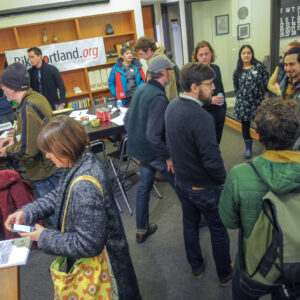
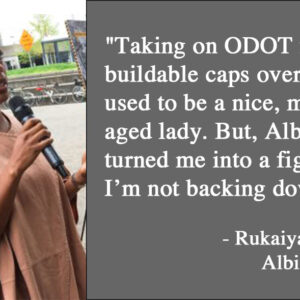
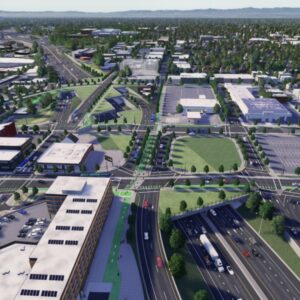
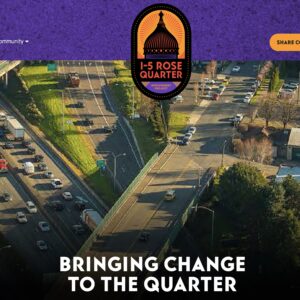
Thanks for reading.
BikePortland has served this community with independent community journalism since 2005. We rely on subscriptions from readers like you to survive. Your financial support is vital in keeping this valuable resource alive and well.
Please subscribe today to strengthen and expand our work.
Let’s add a million new people and actually take away roads. Sounds like a great idea to me!
Your arguments are just that. arguments. We do actually need smart growth in the transportation system. This blind “absolutely nothing” is almost funny.
Meanwhile, the area gets backed up and cars flow out and onto roads like MLK and 7th….. Why not put cars where they belong. On freeways.
billyjo,
Yes I agree these are all arguments. But as a taxpayer funded government entity ODOT has the responsibility to be honest and unbiased with how they frame their plans to the public. I don’t think they are fulfilling that obligation.
As for arguments. I think we need to do much more to limit the convenience and speed of driving and encourage people to make different decisions. Too much driving is having an immeasurable negative impact on our city and our planet and it’s time to do things differently. ODOT thinks this project is great and innovative because they’ve partnered with PBOT and because it’s not as bad as the freeway projects they tried to get away with in decades past. I don’t think this project is a good decision. And the more time people have to see the truth behind it, the larger the opposition to it is growing.
So yes, let’s have an argument about the right way to grow. My concern is that ODOT puts their finger on the scales and their PR spin does not allow the community to have an honest debate with an unbiased look at what to expect.
Aside from bike lanes and other non car projects, are there any road projects you support? It all just comes across as heads in the sand, let’s try to find a flaw….. but it seems that flaw you think you found is semantics, arguing over what is a lane.
We need auto infrastructure and we need bike infrastructure. This project helps car trips without throwing those cars onto the same roads as bikes and I’m all for that.
That’s a good question billyjo. And a very big question.
First, I think you might not fully understand my perspective. I am anything but “head in the sand” and I try to keep an open mind about everything.
Semantics are important to me because ODOT is playing with our money and I have many reasons to distrust them with it. It’s my feeling that they will do anything to continue business as usual because right now they see big freeway megaprojects as the main way they can survive and continue to feed a 5,000 employee bureaucracy. In other words, I worry ODOT makes decisions based on what’s good for them and what’s good for a harmful status quo — and based on what’s truly good for Oregon.
It’s 2019 and we must take a different approach to transportation. ODOT is not evolving fast enough and this project is a great example of that.
Yes we need infrastructure to drive on, but in my opinion we already have plenty of it. We just don’t use it efficiently because we make driving way too cheap and easy. There are many other solutions that would increase capacity of all users (not just drivers!), but because ODOT is so driving/auto-centric they do not care about them.
Other ideas:
– This project should consider the impacts of tolling. ODOT hates the idea of tolling because they fear it will soften the market of what they see as their primary customer: drivers. There is very good reason to believe that if we tolled I-5 we could gain more efficiency.
– If the problem is safety and operations, why not simply focus on safety measures like slower speeds, signage, and enforcement of dangerous drivers?
– ODOT didn’t take a serious look at a transit solution to this congestion problem. How much freeway space could we free up if we created a bus rapid transit system on I-5 between Lloyd Center on I-84 and the Fremont Bridge? We don’t know because ODOT didn’t look into that.
The list goes on and on. I don’t think in 2019 we should be expanding driving capacity. It is not a smart idea given where we are in terms of climate change and the vast negative external impacts that driving has on our community (which goes way beyond toxic emissions by the way).
thanks for your comments
JM, ODOT is studying tolling, including congestion pricing. Contrary to what you say above, there is tremendous support for tolling inside the agency. Yes, there are old-school engineers who want to widen freeways to add capacity, but there are plenty of others who see lots of value in congestion pricing and tolling.
I frankly don’t care how much the agency supports tolling if it only leads to nice statements and studies. This project is a perfect candidate to try tolling and if they wanted to, I’m sure ODOT could work with the OTC and legislators to find a way to pilot a pricing plan. I think tolling deserves more urgency and it deserves to be tried here. ODOT has done everything they can to stall it and make it seem like this project could never be subject to tolling. One of the main project people even dissed tolling in front of Portland City Council, saying it was bad for people who have low-incomes. That kind of biased slip by an ODOT staffer illustrates the cultural climate of the agency imo. And have you seen ODOT’s recent propaganda videos about congestion? They dismiss tolling as being “years away.”
Again. ODOT knows tolling will force a fundamental shift to their current business model and they don’t want to make that shift and/or they’re too scared to let it play out.
This shows me how little you know about tolling implementation and the environmental process associated with it, design, setting up a back office system etc. Why don’t you look at other states and see how fast they rolled it out. It does take study (yes, years) to understand the impacts and develop mitigation strategies for those negatively impacted by it. (Whether that’s the cost of tolling, diversion to local streets and transit planning.) Sorry, that’s reality.
Thanks for the reply.
To be clear… the lack of tolling as an option here is just one of many things that concern me about this project.
And has been said before, toll first, then determine if congestion is still a problem.
right.
And everyone should know that there isn’t any money made available for this project until 2022. And that’s only $30 million per year to pay for bonds. There’s a very good chance we will have clarity on tolling by then.
They are and that is why the omission in the EA is so galling. As a foreseeable option given the aforementioned studying they should have included two additional options which would have shown the system impacts if tolling we implemented in both the “Build” and No Build” scenarios. Acting as though that is unrelated goes against the entire premise of environmental review.
The fact that it’s not meaningfully considered in the EA is a problem. We can speculate that it’s either because they don’t think it will be implemented or because it would show many of the same “benefits” of the “Build” option without having to issue nearly half a billion in bonds (in fact becoming a revenue stream that could be used to construct buildable lids which are also missing from this project’s consideration). Ultimately we don’t know because it’s not considered.
I went to one of ODOT’s public info opportunities on the tolling considered for I-205 and I-5. I’m a fan of the idea of congestion charging, as implemented in cities like London, Singapore, Oslo and Milan. But that’s not at all what’s under consideration in Portland and not at all like any tolling scheme that’s ever been implemented in the States. Congestion charging is a scheme designed and carried out for the express purpose of curbing car use and shifting modal share to more sustainable alternatives. The tolling scheme under consideration here is just meant to raise money for freeway construction. In Oregon, it’s not even legally possible to channel road tolling revenue to public transport or anything else other than building roads. So as much as I admire the idea of congestion charging, that’s not what’s at play here, and I don’t support it.
Please read the Oregon constitution before paraphrasing or repeating this myth that tolling revenue must build roads. If enough people actually read it, someone might notice the “use of” bit means we can fund transit operations with it.
That’s a lot of typing to avoid saying no.
Your position is not as nuanced as you believe it is.
I also think it’s telling that people like me who are saying we need to try something different are the ones you think are putting “heads in sand”. Seems to me that seeing congestion and thinking a wider freeway is the answer is the definition of having one’s head in the sand and not being open to any other, more modern, solutions.
Metros that have gone all-in on freeway construction, like LA and Houston, have horrible traffic, worse than Portland. Why would we throw money away when there’s clear evidence that more roads won’t solve congestion? But can you imagine the outrage from motorists if we proposed spending this same sum on bike and transit improvements?
this isn’t a matter of building more roads, but is a matter of utilizing the roads (and their right of ways) to the best of their potential.
By that definition, turning a 4-lane highway into an LA-style 8-lane highway isn’t building more roads, it’s just utilizing the right of way. Semantic games aside, we’re spending money on putting down more asphalt that cars will drive on…how do you think the crews working on it will describe how they spend their day?
“this isn’t a matter of building more roads, but is a matter of utilizing the roads (and their right of ways) to the best of their potential.”
Exactly! And the best use is not more single occupancy motor vehicles on those roads. The best use is a more dense form of transportation that uses the road to it’s potential.
Because it is the easiest proven way to grab huge sums of money to throw around to ODOT employees and contractors?
I don’t think it’s possible to “solve” congestion. It’s a question of how much does one lessen it. Even though Copenhagen (beloved by cycling activists!) has the least amount of congestion among Scandinavian cities, it still has congestion problems. Let’s not pretend the issue goes away with some bike lanes.
right: if it’s never going away, why throw away so many resources and cause so much damage to quality of life and public health trying to make it go away?
It is indeed possible to severely mitigate congestion during peak hours. Many cities have successfully done so.
https://nyc.streetsblog.org/2017/11/28/congestion-pricing-was-unpopular-in-stockholm-until-people-saw-it-in-action/
We need more auto infrastructure like drug addicts need more drugs. What we really need is to get off the crack and move towards a clean and healthy life. This is difficult to see for those deep within the fog of auto addiction but it is the only real choice. Doubling down on a transportation experiment that has been tried for 100 years and has brought us mostly sprawl, death, environmental destruction and a cartoonish grotesque landscape that has diminished all of our lives is not a logical choice. At the very least lets stop building new auto infrastructure and also stop fixing the existing infrastructure as it ages and breaks down and just convert it to better uses.
If the goal is to keep the cars on the freeways, why is this project doubling the capacity of many of the onramps and offramps in the area? The I-5 N to Weidler exit is now 2 lanes instead of one, for example. Crossing that offramp “yield” already is sketchy. Good luck with two lanes!
We have really, really good auto infrastructure. You can drive to nearly any spot in the city with ease, in well-identified, standard lanes, automated signals that detect your car, etc. Can you do that on your bike? Can you do that on public transit? Why should we spend more money accommodating cars?
I would beg to differ on the idea that we have really good infrastructure for cars. Why are we so high on the list for congestion and commute times? Yet somehow we should absorb a million more people with no growth?
The problem with this particular spot is all the people getting on and off. It slows the through traffic, plus if you want to go from Broadway north, often it makes more sense to skip the freeway entirely and just hit MLK. Yes, it’s slow, but so is the freeway.
These lanes should help that problem and get traffic moving.
Actually, we are nowhere near the top for average commute times:
https://www.indexmundi.com/facts/united-states/quick-facts/cities/rank/average-commute-time
The “congestion” measure is deeply flawed, favoring sprawling cities with high-speed highways. Congestion is stupid measurement. Commute time is the thing that actually affects your quality of life, and is what we should be looking at. Portland is better than many similarly sized cities because we are denser, with shorter commute distances.
Your points on the bottleneck are valid, but you don’t seem to get the bigger picture here. We can’t accommodate 1 million new residents driving cars. We simply don’t have the space and money to widen our highways. This project is half a billion dollars to add a few miles of lanes to I-5. How much are you willing to pay in taxes so Clackamas and Clark county residents can drive 50mph to get to work in the city?
Have you been to LA, Houston, or Atlanta? Their 12 lane freeways are just as congested as ours. Wider freeways are not a solution to traffic. The costs increase exponentially, and the congestion persists.
Buying larger pants has never inspired me to eat healthier or get more exercise.
But never changing your belt will cut off circulation and cause health impacts.
And it is going to be much healthier if you find alternatives like exercise and better eating, rather than just getting fatter and fatter.
Stop being a shill for the big belt lobby!
Says the suspender guy.
It seems that the key frustration with this project is that money is being spent on cars rather than other modes of transport.
What do you do when you live in a city where a small percentage of the population uses alternative modes of transportation and the rest simply do not care? Can you blame a government for doing what the vast majority of its residents actually want? Is making the status quo absolutely miserable the best way to promote an alternative?
From a driving perspective the I-5 project makes a great deal of sense. They have done projects like this where I-84 meets I-205 and it has removed bottle necks and allowed traffic to move much smoother. It removes the open road to parking lot traffic jam pattern.
good questions Adam. If I knew the perfect answers I would run for Governor.
here’s a try:
– I would disagree that a “small percentage” of people use non-driving modes. Especially in Central City area, if you combine biking, walking, and transit (streetcar, bus, MAX), you’d have a significant percentage.
– And I’m a firm believer that the only reason more people don’t use walk/bike/transit is because of agencies like ODOT that fail to make the projects we need and continue to make the projects they want. And by “need” I mean the projects that we (as a city!) have adopted in our plans and policies. Expanding driving infrastructure in Portland’s central city isn’t supported by any of Portland’s adopted transportation/climate/land use/etc. plans.
– I firmly disagree that more driving infrastructure is what most people want. It’s what most people think they want because it’s what the gov’t has been duped into thinking is the only solution. How have they been duped? By several generations of corporate lobbying that has favored driving over everything else. This isn’t a conspiracy. It’s a fact. Goodyear, Ford, GM, Exxon, etc… have a vast influence on our politics and they all way to see more people driving more private cars. See the Oregonian’s excellent “Polluted by Money” series for a very timely and relevant example of this.
– And while this might make sense from a driving perspective, the driving perspective is not the one we should listen to. It’s 2019 and there are much better ways to solve these problems. We should try them.
I ride through this area on my daily commute. I think the improvements will work well for moving bikes through the area, especially the ped/bike bridge. It will make the Rodney, Tillamook and (future) 7th greenways more accessible from the Rose Quarter, which will lessen the strain on the Williams bikeway. I expect to use this bridge regularly.
I support this project.
thanks for sharing that pdxpaul.
Another thing about this that makes me uncomfortable is that we’re being asked whether we support the project or not. And there’s this snowball of bureaucratic inertia with the EA and ODOT… But ODOT also likes to say the project is still in “Very early stages”. It’s very important to understand that according to ODOT none of the bikeway designs have been fleshed out. There are no design drawings, just sketches and promises. So we’re being asked to comment on a project with elements that haven’t even been designed yet! Then once it comes time to influence the design, we will often hear ODOT say, “Sorry that decision has been made and we can’t change x/y/z element.” It’s very frustrating and it’s another thing that sows distrust imo.
Right now there is a project that they’re working on on NE 7th. That street has too many cars. One big problem there is that so many cars use that street to avoid the traffic on MLK. So many people on MLK are there to avoid the traffic on I5…….
If you’re worried about cut-through traffic using 7th like a highway (and I am as well), wouldn’t it be easier/cheaper/more effective to construct diverters? It worked on Going. Nobody is using Going as a bypass to I-84, Columbia/Lombard, etc.
diverters would just move the problem over a few blocks.
Ya back to MLK. Just like the 50th and Lincoln diverter. If someone wants to go from 50th to 60th now they have to take Division or Hawthorne.
And where 26 meets 217. That westbound bottleneck has been significantly reduced with the change.
Where is the evidence that the I-84 to I-205 project has reduced congestion on I-84 eastbound? I drive this a lot, and it seems like it just forces more traffic to the far right lane, making it difficult to get off at Gateway, and creating dangerous lane changing behavior just after the I-205 south offramp…
On the other hand, the increase in cars on the neighborhood streets is making bike commuting more dangerous. I’d like us to examine realistic infrastructure building for all the modes of transportation.
That’s where the induced demand part comes in. Sure, a freeway widening *might* relieve congestion in the short term such that it entices car commuters off those neighborhood streets and back onto the freeway. But, over a long enough horizon, this just ends up fueling more sprawl development (“drive till you qualify”) as people are willing to commute (in distance) just a little bit farther now that driving times through RQ have temporarily improved. Next thing you know we’re back to where we started; just with more exhaust fumes floating through Tubman.
Infrastructure spending is always a real estate (land use) play. And while the idea of living/commuting from outer Clark County sounds terrible to me, it doesn’t seem to bother a lot of people. Fine, different strokes. But I don’t see why we should be paying for their lifestyle choices with our tax dollars and via sacrificing the respiratory health of our middle schoolers.
it is very telling that Don HAmilton want to give the freeway “breathing room” at the expense of the asthma sufferers who live along the damn thing!
Just how many people was that?
the air quality in Portland is near the worst in the country, and our asthma rates are extremely high. Air quality is very serious, and automobile traffic is worst contributor, worse than industry, train and river traffic.
Tens of thousands, including my family. How much is a human life worth, in your view?
Four people within my immediate family. The impact is more pronounced among non-white youth populations and people identifying as multiracial. Mitigating asthma from freeways is a racial equity issue as well as a health issue.
https://www.cdc.gov/asthma/stateprofiles/Asthma_in_OR.pdf
I’ve been conducting a personal experiment with transportation through this region, as I’m considering something that will give me a 10-mile each-way daily trip right through this whole project. Driving a personal vehicle by myself takes 20-40 minutes. Including a lot of not-moving during that time, but I get to listen to NPR. Riding a bike takes about 60 minutes, on roads with pretty decent cycling infrastructure (though it’s been telling how impactful the Eastbank Esplanade closure has been to my routing — it’s not trivial). Taking transit takes 90 minutes. The place I would be driving a car to offers free daily storage of my vehicle but no subsidy for transit or cycling.
So, even if we do nothing, if we’re talking about throughput and transit times and convenience, the personal car driven all by myself ‘wins’. It wins with infrastructure support and business support. Now I strongly believe that the personal car option has huge societal costs to our local community and our future ability to even live on this planet. I see $500 million to reduce that 40 minute travel time to 35 minutes (if we just go with the false assumption that there won’t be more people in vehicles on the road) and the money doing NOTHING to address the status quo and the mess we’re in. The ODOT EA leaves this big glaring part of the analysis out of the picture and it’s wrong. We, as a community, should know what impact this project will have on the air quality and GHG emissions in contrast to options that get single-occupant personal vehicles off the road. That is how ODOT is obfuscating and defending the way things have always been done.
You left out the exercise potential benefits to your cycle trip. Even if your car trip takes 40 minutes less you’ve still lost out on 20 minutes of other time you now have to spend getting just as much exercise. You could also listen to NPR while cycling, or taking public transit negating that positive benefit to driving.
“The place I would be driving a car to offers free daily storage of my vehicle but no subsidy for transit or cycling.”
This is what did it for me. My office used to provide either “free” parking OR a transit pass. Driving back then was a clear “winner” time-wise, at 30-40 minutes in and 20-30 minutes home vs. riding my bike at 60 minutes each way vs. transit at ~80 minutes. Driving cost me marginally more than the other options for gas and wear & tear. I still rode my bike to work a few times per week, just for the challenge and exercise—and it was usually less stressful than driving.
Nowadays, the commute subsidies from my employer are either partial parking, which leaves a likely $150/month out-of-pocket for me, OR transit pass. Time-wise, driving would still be the clear winner, as biking and transit take about the same 60 minutes each way, and driving would be less (I have found that if I can time things perfectly while riding to the right MAX stop, biking plus transit can take as little as 47 minutes). But the cost of parking is not worth it to me, if I can take transit or ride my bike for “free”. The extra effort and 40-60 minutes/day is not worth the $150/month plus stress for driving and parking.
The only bummers besides time are
1) MAX only comes by every 15 minutes, so if I am 30 seconds late leaving the house, I am 15 minutes late to the office. This effect can happen with driving as well, if one doesn’t time for the “wave” of rush-hour traffic.
2) There are frequent delays and stoppages of MAX due to “police activity” and other reasons (sometimes drivers crashing into trains). This can also happen while driving if there is a crash or other “incident” that stops traffic.
3) I’ve witnessed one assault and one medical emergency on the train, which never happened while driving (although I’ve crashed while riding my bike, so there’s that).
So I am one for whom the convenience of driving was canceled out by the cost of driving (parking) and am willing to spend a little more time and effort to save the money. Furthermore, ODOT had nothing to do with it; it was strictly a change in policy by my employer. I suppose downtown employers consider it a competitive advantage when attracting top talent if they can entice potential employees with “free” parking, but imagine if that stopped happening and employers only offered transit passes. What would that do to freeway capacity?
I’m no traffic engineer, I’m just a citizen responding to what I’ve seen and been told, so I don’t pretend to have an informed or complete opinion. However, I am also a partial representative of the vast majority of people who live in this city and will be impacted by this project.
I am not against relieving the “bottleneck” through the rose quarter. I don’t drive it often, but it seems crazy every time I do drive on it to go from 3 or four lanes down to 2 and then back up to 3. Adding lanes has a certain logic. However, I am concerned that this is not what ODOT is actually proposing. Otherwise they would be clear and honest in describing the project. Similar to the Columbia Crossing bridge project actually having little to do with replacing a bridge, it sounds like the vast majority of money spent on this project has nothing to do “adding lanes” or “fixing the bottleneck.” If it were, ODOT and the project’s supporters wouldn’t have to work so hard to sell it.
Jonathan makes a fair point that ODOT has probably not looked at alternative solutions to problems created by congestion through the city center. They have also not done much to build trust with the public since they seem enamored more with big projects and less about maintaining and incrementally improving what already exists. I do not particularly trust that ODOT has our best intentions in mind and I believe it is more concerned about satisfying the whims of the government in Salem who controls their budget and who have decreed that a big, flashy project in Portland will keep the voting public in line.
Finally, someone above discussed how adding lanes at the I-84 / I-205 and 26/217 interchanges helped congestion. I agree. These are also examples of the kind of project this is not. These were limited projects to improve already existing infrastructure. This project seems like a huge, expensive boondoggle in the making that will likely not even fix the problem it is set out to fix.
Another consideration, brought up at the Bicycle Advisory Committee meeting last night, is how detours and delays during construction will affect cycling on the Williams/Vancouver couplet. The question put was something like, “will cyclists endure the detours and other delays during construction for the next six years, or will many opt to drive instead?”
Considering the effects on cycling after the project is finished, Roger Geller made a handout that showed increased distances and signals from Williams/Vancouver to the Broadway and Steele Bridges.
Link: https://www.portlandoregon.gov/transportation/article/725147
Where do we want “all of these people” who are moving to the metro area to live? In moderately dense areas that do not require VMT or in a sprawl pattern that will generate a ton more pollution and CO2? Anyway you slice it, this project is incentivising suburban sprawl at the expense of the central city that has to absorb all of the crap that goes along with SOV VMT and parking.
Somebody moving here is not even going to think about traffic times to their far out house. They’re gonna look at the 500 square foot 1 bedroom for $3500 a month and then look at the 3,000 square foot 5 bedroom house in the burbs and rent that.
If you’re trying to convince me that I am responsible to pay for that choice by expanding a freeway interchange, you’re not doing a very good job.
If Portland had reasonably priced inner housing you would have a stronger argument. But being able to bike (and mostly take transit) is still a luxury for people who either have been here a long time (and own their house) or have a good bit of money. What is a person making $40-50K supposed to do?
Maybe you could rent an AirBnB. That’s where a lot of the small (i.e. potentially affordable) units are.
What to do? Advocate for investing public funds into expanding rapid transit and safe active transportation into areas that are affordable rather than prioritizing SOV trips, the most expensive, inefficient, resource intensive form of urban transportation.
ODOT is shamelessly obfuscating the fact they are hugely widening this section of the freeway. They are lying about the increased air pollution this will bring. They are misleading people about potential future landscape, too- they will not allow trees to planted within 20′ minimum of the roadway, and their graphics regularly show trees where they will not be allowed. They also trees on the structures/covers but that is is infeasible under any existing precedents or agreements. They also show the lids as outdoor gathering spaces, but the noise levels will preclude this (in addition to disconnection from the urban fabric, the lack of living vegetation and shelter, and the complete lack of program due to their isolated locations). ODOT is also minimizing how they this project will make the surface streets faster and more dangerous by increasing radii and compromising the pedestrian fabric. ODOT is pretending to be improving the bike network but they are actually removing the Flint overpass and not replacing it, the bridge they are adding is in a worse location and has much steeper grades. There is so much spin, misinformation and green-washing in this report, any political leader should be very alarmed. I am very disappointed that Lew Frederick is backing this.
Due the least costly improvements first. First start tolling/congestion pricing yesterday, $600 million is A LOT of money, it’s going to take awhile. Really want to improve the city? Use the money to build some affordable housing (I know you can’t use ODOT $ for that)., but they do camp on the freeways!
For perspective, Tri-Met’s annual budget is about $500 million…I’m kind of dumbfounded that we’re even considering spending a similar amount of money to build 3 miles of additional lanes. From an ROI perspective, expanding the freeway here doesn’t make any sense.
“But as a taxpayer funded government entity ODOT has the responsibility to be honest and unbiased with how they frame their plans to the public.”
https://www.oregonlive.com/portland/2019/03/portland-trumpets-rosy-numbers-for-controversial-infill-plan-buries-dimmer-forecast.html
Get off your bike high horse and learn that a lot of people don’t like getting soaked on their commutes. Start preaching scooters and motorcycles as a way to commute and you might get more pull. Take a look at the studies of alleviated congestion if you just convince 10 percent to switch. It’s still a motor and gets you to where you need to go as fast as a car. You may still get wet but at least you won’t have to take a shower because you stink from all the sweat after peddling.
Sounds like a personal problem to me.
I think ODOT is taking the view that the wide landscaping buffer is part of their operational right-of-way – that is, it’s owned and maintained by ODOT as part of the highway. I think that’s essentially correct, unless PBOT owns some or all of that, which I strongly doubt. Therefore, they may be correct in asserting that the footprint isn’t getting any bigger.
The assertion that this isn’t adding lanes or inducing additional car traffic appears to be counter to fact since we all have eyes and can clearly see the additional lanes (doesn’t matter what you call them). I’m not opposed to this project, but I do wish that ODOT would be straightforward about it. The ODOT spokesperson isn’t helping his case by obfuscating the truth.
How do we unbundle the Albina Vision? This should be the next conversation.Very disappointed that Lew is digging in on this one and no response from Albina Visionaries on advocating to de-bundle the Albina Vision from the Rose Quarter. He wants the Albina Vision and the idea that his district can ‘save’ us from PDX congestion relief and economic development. This is the issue, walking away from the largest project in your district and starting from scratch on manifesting Albina Vision. I believe bundling the two has pitted has community members.
This is the transportation part of a major urban renewal project. If you were opposed to this you should have become involved when it was circulating through the PDC and the Portland planning commission. It only makes sense to fix the basic surface transportation issues (mostly the I-5 bottleneck) before committing to allowing the major redevelopment that Portland planners envision for this area.
In other words, the ship has already sailed.
It’s hilarious to me that anybody thinks after half the state of California moving here, those people are just going to give up their cars and get on a bike. Driving is their culture, it’s all they know.
They can do as they like. Doesn’t mean we need to pay a half billion dollars to make it easier for them to do so.
Do you believe your attitude is prevalent?
The data is that longer distance cycling virtually disappears during our rainy, dreary winters. Seems to work fine in the core areas; but, dude, I live right on the Springwater and poof! go the bikers when the heavy rains hit. So that will probably be the case with any longer distance routes. What to do for the shorter, inner city routes? Maybe Elon Musk’s tunnel boring apparatus will provide an answer one day .
I moved here specifically to ditch my dependence on a car for daily living (aka work and school commute). As such we deliberately chose housing that was close in, that cost more, because a) we weren’t pay for insurance/gas/parking and b) the quality of life tradeoffs were a thousandfold better than spending ‘free time’ in a vehicle. The city has the power to attract the people they WANT to move here and we can do that by not following the rest of this country into car despair.
***Portions of comment deleted – Tony if you want to comment here please don’t be so mean to people you’ve never met before. Thanks – Jonathan***.
I bet if you cry hard enough cars will just go away.
There doesn’t look to be a shred of land that isn’t already theirs that is going to taken for this. Not a bit. Adding these on and off ramps will do wonders for relieving traffic, no matter your green anarchist beliefs on the subject.
All you’re doing is making people like me who were ambivalent to your causes oppose them because they are being represented by someone whose head is on another planet.
“…someone whose head is on another planet.”
Anyone who is worried about the destructive nature of car-only travel definitely has his or her head squarely on this planet, because they can see what it is doing to this planet. Even if you’re a climate change denier, the destruction of rampant auto overuse goes far beyond the climate.
I mean, to say anyone is “saving the planet” is a little disingenuous unless Darth Vader happens by with the Death Star, since “The Planet” will continue to exist and its natural systems will function just fine long after we’ve killed ourselves off. By choosing to curb destructive practices we are saving ourselves and our ability to live here.
Someone might want to send some City of Portland resources to ODOT.
> News Blog: A primer on congestion pricing, why Portland doesn’t plan to build any new freeways, and benefits for low-income commuters
https://www.portlandoregon.gov/transportation/article/664982